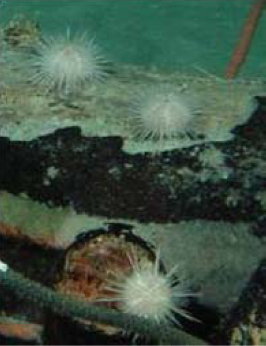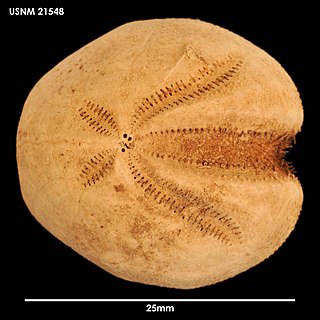
The Echinothurioida are an order of sea urchins in the class Echinoidea. Echinothurioids are distinguished from other sea urchins by the combination of a flexible test and hollow spines. The membrane around the mouth contains only simple plates, in contrast to the more complex mouth parts of their close relatives, the Diadematoida. They are nearly all deepsea dwellers.

The Camarodonta are an order of globular sea urchins in the class Echinoidea. The fossil record shows that camarodonts have been in existence since the Lower Cretaceous.
Amphipneustes bifidus is a species of sea urchin. Their armor is covered with spines. It is placed in the genus Amphipneustes and lives in the sea. Amphipneustes bifidus was first scientifically described in 1950 by Ole Mortensen, a Danish scientist.
Anabrissus damesi is a species of sea urchin of the family Brissidae. Their armour is covered with spines. It is placed in the genus Anabrissus and lives in the sea. Anabrissus damesi was first scientifically described in 1881 by Alexander Agassiz, American scientist and engineer.

Anametalia grandis is a species of sea urchin of the family Brissidae. Their armour is covered with spines. It is placed in the genus Anametalia and lives in the sea. Anametalia grandis was first scientifically described in 1950 by Ole Mortensen.

Araeosoma owstoni is a species of sea urchin of the family Echinothuriidae. Its armour is covered with spines. It is placed in the genus Araeosoma and lives in the sea. A. owstoni was first scientifically described in 1904 by Ole Theodor Jensen Mortensen.

Asterechinus elegans is a species of sea urchin of the family Trigonocidaridae. Their armour is covered with spines. It is the only species in the genus Asterechinus and lives in the sea. Asterechinus elegans was first scientifically described in 1942 by Ole Theodor Jensen Mortensen.

Breynia elegans is a species of sea urchins of the family Loveniidae. Their armour is covered with spines. Breynia elegans was first scientifically described in 1948 by Ole Theodor Jensen Mortensen.

Brisaster antarcticus is a species of sea urchins of the family Schizasteridae. Their armour is covered with spines. Brisaster antarcticus was first scientifically described in 1906 by Döderlein.
Brisaster fragilis is a species of sea urchins of the family Schizasteridae. Their armour is covered with spines. Brisaster fragilis was first scientifically described in 1844 by Düben & Koren.

Brisaster latifrons is a species of sea urchins of the family Schizasteridae. Their armour is covered with spines. Brisaster latifrons was first scientifically described in 1898 by Alexander Emanuel Agassiz.

Brisaster moseleyi is a species of sea urchins of the family Schizasteridae. Their armour is covered with spines. Brisaster moseleyi was first scientifically described in 1881 by Alexander Emanuel Agassiz.
Brisaster tasmanicus is a species of sea urchins of the family Schizasteridae. Their armour is covered with spines. Brisaster tasmanicus was first scientifically described in 1974 by McKnight.
Brissalius vannoordenburgi is a species of sea urchin in the Family Brissidae. Their armour is covered with spines. Brissalius vannoordenburgi was first scientifically described in 2008 by Coppard.
Brissopsis evanescens is a species of sea urchins of the family Brissidae. Their armour is covered with spines. Brissopsis evanescens was first scientifically described in 1950 by Ole Theodor Jensen Mortensen.

Brissus meridionalis is a species of sea urchins of the family Brissidae. Their armour is covered with spines. Brissus meridionalis was first scientifically described in 1950 by Ole Theodor Jensen Mortensen.
Chaetodiadema japonicum is a species of sea urchins of the Family Diadematidae. Their armor is covered with spines. Chaetodiadema japonicum was first scientifically described in 1904 by Ole Theodor Jensen Mortensen.

Araeosoma is a genus of deep-sea sea urchins in the family Echinothuriidae.
Schizasteridae is a family of echinoderms belonging to the order Spatangoida.
Brisaster is a genus of echinoderms belonging to the family Schizasteridae.












